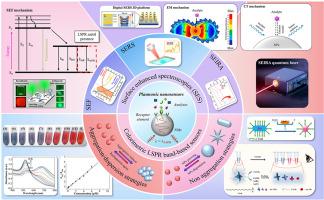涉及纳米材料的表面等离子体共振光学传感器作为可靠的分析工具:对性能和应用的批判观点
IF 6
2区 化学
Q1 CHEMISTRY, ANALYTICAL
引用次数: 0
摘要
在过去的二十年中,人们对新型化学传感器的发展越来越感兴趣,这种基于纳米材料的“纳米传感器”设备,由于其多用途和创新的特性,因此能够建立更有效的转导和识别过程。其中,金属纳米粒子(MNPs)由于其表面表现出局域表面等离子体共振(LSPR)现象,在传感器结构中的作用值得重视。这些提供了有趣的分析可能性,结合了新的优势或新的选择,相对于当前的最先进的技术和今天的问题解决方案。本文综述了基于金属纳米材料LSPR效应的光学传感器的具体转导机制和性能改进的最新进展,以及分析表征策略和最相关的应用。具体来说,它是针对两大类光学技术,这是基于不同的物理化学转导机制。第一类包括表面增强光谱(SES),它利用分析物与金属纳米颗粒(NPs)附近产生和定位的强电磁场之间的相互作用。第二类包括可见光范围内基于LSPR波段消光的光学传感器,其中辐射的吸收由NPs周围介电环境的变化调制。作为结论性评价,提供了最后的关键概述,特别关注当前的挑战和限制,以实现可靠的分析确定。本文试图从技术和关键的角度强调,最近设计的涉及基于MNPs的等离子体共振光学传感器的纳米技术和仪器策略的现状,这些策略在不同LSPR技术的传感范围方面已经达到了非常不同的成熟度和性能程度。所有概述的策略都通过选择分析兴趣的应用进行了举例说明。本文章由计算机程序翻译,如有差异,请以英文原文为准。

SURFACE PLASMON RESONANCE OPTICAL SENSORS INVOLVING NANOMATERIALS AS RELIABLE ANALYTICAL TOOLS: A CRITICAL VIEW ABOUT PERFORMANCE AND APPLICATIONS
Background
In the last two decades, there has been an increasing interest in the development of a new category of chemical sensors incorporating "nanosensor" devices, which are based on nanomaterials, thus enabling the establishment of more efficient transduction and recognition processes due to their versatile and innovative properties. Among them, the role of metallic nanoparticles (MNPs) for the construction of sensors should be highlighted due to the Localized Surface Plasmon Resonance (LSPR) phenomenon exhibited on their surface. These open interesting analytical possibilities, incorporating new advantages or new alternatives with respect to the present state-of-the-art and today problem solving.Results
This review aims to provide an overview of the current state of the art in terms of specific transduction mechanisms and performance improvements on substrates, as well as analytical characterisation strategies and the most relevant applications of optical sensors based on the LSPR effect of metallic nanomaterials. Specifically, it is aimed at two major categories of optical techniques, which are grounded by distinct physicochemical transduction mechanisms. The first category encompasses surface-enhanced spectroscopies (SES), which exploit the interaction between analytes and the intense electromagnetic fields generated and localized near metallic nanoparticles (NPs). The second category comprises those optical sensors based on the LSPR band extinction within the visible range, where the absorption of radiation is modulated by changes in the dielectric environment surrounding the NPs. As a conclusive evaluation, a final critical overview is afforded, with particular concern to current challenges and limitations to achieve reliable analytical determinations.Significance
The review tries to highlight, from a technical and critical point of view, the state of art of those nanotechnological and instrumental strategies recently designed involving plasmon resonance optical sensors based on MNPs, which have conducted to a very different maturity and performance degree regarding sensing scopes for the different LSPR techniques. All the outlined strategies have been exemplified with selecting applications of analytical interest.求助全文
通过发布文献求助,成功后即可免费获取论文全文。
去求助
来源期刊

Analytica Chimica Acta
化学-分析化学
CiteScore
10.40
自引率
6.50%
发文量
1081
审稿时长
38 days
期刊介绍:
Analytica Chimica Acta has an open access mirror journal Analytica Chimica Acta: X, sharing the same aims and scope, editorial team, submission system and rigorous peer review.
Analytica Chimica Acta provides a forum for the rapid publication of original research, and critical, comprehensive reviews dealing with all aspects of fundamental and applied modern analytical chemistry. The journal welcomes the submission of research papers which report studies concerning the development of new and significant analytical methodologies. In determining the suitability of submitted articles for publication, particular scrutiny will be placed on the degree of novelty and impact of the research and the extent to which it adds to the existing body of knowledge in analytical chemistry.
 求助内容:
求助内容: 应助结果提醒方式:
应助结果提醒方式:


